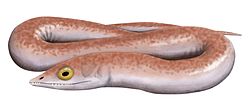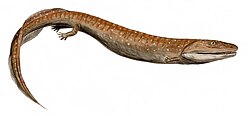Paleobiology
A rise in global oxygen content allowed for the evolution of large, predatory fish that were able to exploit the shallow tidal areas and swamplands as top predators. [8] Several groups evolved to fill these niches; the most successful were the elpistostegalians. In such environments, they would have been challenged by periodic oxygen deficiency. [9] In comparable modern aquatic environments like shallow eutrophic lakes and swampland, modern lungfish and some genera of catfish also rely on the more stable, atmospheric source of oxygen. [10] [11]
Being shallow-water fishes, the elpistostegalians evolved many of the basic adaptions that later allowed the tetrapods to become terrestrial animals. The most important ones were the shift of main propulsion apparatus from the tail fin to the pectoral and pelvic fins, and a shift to reliance on lungs rather than gills as the main means of obtaining oxygen. [12] Both of these appear to be a direct result of moving to an inland freshwater mode of living. [13]
Fossils of Panderichthys are dated to the Givetian (around 385 million years old) or the Frasnian (around 380–375 million years old [14] ). [1] Thus, the oldest bone remains of elpistostegalians appear in the late Middle Devonian or in the early Late Devonian. However, a series of trace fossils from the early Middle Devonian of Poland suggests that tetrapod-limbed animals may have existed as early as in the Eifelian, around 395 million years ago. [2]
Phylogeny
The name, originally coined around the genus Elpistostege , later become a synonym for Panderichthyida. [12] In most analyses, the group as traditionally imagined is actually an evolutionary grade, the last "fishes" of the tetrapod stem line, though Chang and Yu (1997) treated them as the sister clade to Tetrapoda. [15] [16] Elpistostegalia was re-defined as a clade containing Panderichthys and tetrapods. [7]
Below is a cladogram from Swartz, 2012. [7]
The 2020 study by Cloutier et al. revealed that the paired fins of Elpistostege contained bones homologous to the phalanges (digit bones) of modern tetrapods. The analysis carried out in this study recovered Elpistostege as the sister taxon of all unequivocally digited vertebrates. [17]
This page is based on this
Wikipedia article Text is available under the
CC BY-SA 4.0 license; additional terms may apply.
Images, videos and audio are available under their respective licenses.






